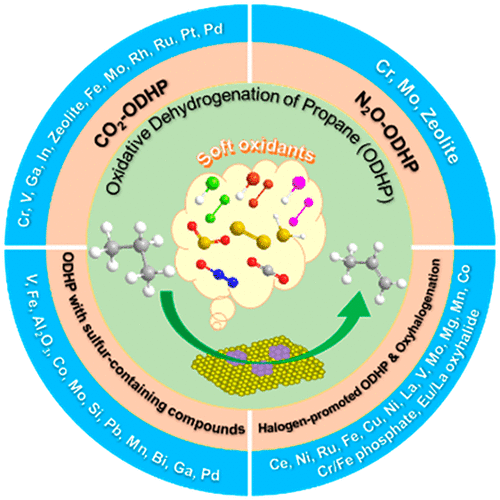当前位置:
X-MOL 学术
›
ACS Catal.
›
论文详情
Our official English website, www.x-mol.net, welcomes your
feedback! (Note: you will need to create a separate account there.)
Oxidative Dehydrogenation of Propane to Propylene with Soft Oxidants via Heterogeneous Catalysis
ACS Catalysis ( IF 11.3 ) Pub Date : 2021-02-04 , DOI: 10.1021/acscatal.0c03999 Xiao Jiang 1, 2 , Lohit Sharma 3 , Victor Fung 2 , Sang Jae Park 4 , Christopher W. Jones 4 , Bobby G. Sumpter 2 , Jonas Baltrusaitis 3 , Zili Wu 1, 2
ACS Catalysis ( IF 11.3 ) Pub Date : 2021-02-04 , DOI: 10.1021/acscatal.0c03999 Xiao Jiang 1, 2 , Lohit Sharma 3 , Victor Fung 2 , Sang Jae Park 4 , Christopher W. Jones 4 , Bobby G. Sumpter 2 , Jonas Baltrusaitis 3 , Zili Wu 1, 2
Affiliation

|
Oxidative dehydrogenation of propane to propylene can be achieved using conventional, oxygen-assisted dehydrogenation of propane (O2–ODHP) or via the use of soft oxidants, such as CO2, N2O, S-containing compounds, and halogens/halides. The major roles of soft oxidants include inhibiting overoxidation and improving propylene selectivity, which are considered to be current challenges in O2-assisted dehydrogenation. For both CO2– and N2O–ODHP reactions, significant efforts have been devoted to developing redox-active (e.g., chromium, vanadate, iron, etc.), nonredox-type main group metal oxide (e.g., group IIIA, gallium), and other transition metal/metal oxide catalysts (e.g., molybdenum, palladium platinum, rhodium, ruthenium, etc.), as well as zeolite-based catalysts with adjustable acid–base properties, unique pore structures, and topologies. Metal sulfides have shown promising performance in DHP, whereas the development of suitable catalysts has lagged for SO2- or S-assisted ODHP. Recently, significant efforts have been focused on homogeneous and heterogeneous ODHP using halogens (e.g., Br2, I2, Cl2, etc.) and hydrogen halides (e.g., HCl and HBr) for the development of facile processes for C3H6 synthesis. This Review aims to provide a critical, comprehensive review of recent advances in oxidative dehydrogenation of propane with these soft oxidants, particularly highlighting the current state of understanding of the following factors: (i) relationships between composition, structure, and catalytic performance, (ii) effects of the support, acidity, and promoters, (iii) reaction pathway and mechanistic insights, and (iv) the various roles of soft oxidants. Theoretical and computational insights toward understanding reaction mechanisms and catalyst design principles are also covered. Future research opportunities are discussed in terms of catalyst design and synthesis, deactivation and regeneration, reaction mechanisms, and alternative approaches.
中文翻译:

非均相催化软氧化剂将丙烷氧化脱氢为丙烯
可以使用常规的氧气辅助丙烷脱氧(O 2 -ODHP)或通过使用软氧化剂(例如CO 2,N 2 O,含S的化合物和卤素/卤化物)实现丙烷氧化成丙烯的氧化脱氢。。软氧化剂的主要作用包括抑制过氧化和提高丙烯的选择性,这被认为是O 2辅助脱氢中的当前挑战。对于CO 2 –和N 2O-ODHP反应,为开发氧化还原活性物质(例如铬,钒酸盐,铁等),非氧化还原型主族金属氧化物(例如IIIA组,镓)和其他过渡金属/金属做出了巨大努力氧化物催化剂(例如钼,钯铂,铑,钌等),以及具有可调酸碱性质,独特的孔结构和拓扑结构的沸石基催化剂。金属硫化物在DHP中显示出令人鼓舞的性能,而合适的催化剂的开发却落后于SO 2或S辅助ODHP。近来,已将大量努力集中在使用卤素(例如,Br 2,I 2,Cl 2等)和卤化氢(例如HCl和HBr)用于开发C 3 H 6的简便方法合成。这篇综述旨在对这些软氧化剂在丙烷氧化脱氢方面的最新进展进行关键,全面的综述,特别着重强调以下因素的当前理解状态:(i)组成,结构和催化性能之间的关系,(ii) )载体,酸度和促进剂的作用;(iii)反应途径和机理见解;以及(iv)软氧化剂的各种作用。还涵盖了对理解反应机理和催化剂设计原理的理论和计算见解。在催化剂设计和合成,减活和再生,反应机理和替代方法方面讨论了未来的研究机会。
更新日期:2021-02-19
中文翻译:

非均相催化软氧化剂将丙烷氧化脱氢为丙烯
可以使用常规的氧气辅助丙烷脱氧(O 2 -ODHP)或通过使用软氧化剂(例如CO 2,N 2 O,含S的化合物和卤素/卤化物)实现丙烷氧化成丙烯的氧化脱氢。。软氧化剂的主要作用包括抑制过氧化和提高丙烯的选择性,这被认为是O 2辅助脱氢中的当前挑战。对于CO 2 –和N 2O-ODHP反应,为开发氧化还原活性物质(例如铬,钒酸盐,铁等),非氧化还原型主族金属氧化物(例如IIIA组,镓)和其他过渡金属/金属做出了巨大努力氧化物催化剂(例如钼,钯铂,铑,钌等),以及具有可调酸碱性质,独特的孔结构和拓扑结构的沸石基催化剂。金属硫化物在DHP中显示出令人鼓舞的性能,而合适的催化剂的开发却落后于SO 2或S辅助ODHP。近来,已将大量努力集中在使用卤素(例如,Br 2,I 2,Cl 2等)和卤化氢(例如HCl和HBr)用于开发C 3 H 6的简便方法合成。这篇综述旨在对这些软氧化剂在丙烷氧化脱氢方面的最新进展进行关键,全面的综述,特别着重强调以下因素的当前理解状态:(i)组成,结构和催化性能之间的关系,(ii) )载体,酸度和促进剂的作用;(iii)反应途径和机理见解;以及(iv)软氧化剂的各种作用。还涵盖了对理解反应机理和催化剂设计原理的理论和计算见解。在催化剂设计和合成,减活和再生,反应机理和替代方法方面讨论了未来的研究机会。











































 京公网安备 11010802027423号
京公网安备 11010802027423号